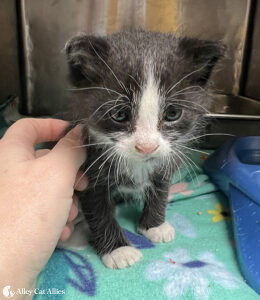
Thor
After 33 years of responding to disasters to protect cats and kittens, Alley Cat Allies knows from experience that the best way to save lives is to be prepared and have a plan in place for our families—including cats—before disaster strikes.
September is National Emergency Preparedness Month, which means it’s a perfect time for all of us to check in and sharpen up our own emergency preparedness.

Nado
From tornadoes in Mississippi and Arkansas to the devastating Maui wildfires, Alley Cat Allies has provided critical emergency support for cats affected by disasters throughout 2023. Thor, a Siamese cat who suffered a severe lower jaw injury when tornadoes tore through his home in Little Rock, is now thriving thanks to an Alley Cat Allies grant for specialized surgery. Nado, a bottle baby rescued from beneath rubble in Mississippi, received round-the-clock care funded by Alley Cat Allies. He has now been adopted and is living his best life with his forever family. You can read more about Thor, Nado, and other cats and neonatal kittens saved through our disaster response here.
But for all the lifesaving work we do in the aftermath of disasters—made possible by our supporters like you—nothing can replace proper emergency preparation.
Here are the top ways you can prepare to keep cats safe in case of a disaster:
1. Keep Records
Have descriptions of your own cats and the community cats you care for, along with photos. Alley Cat Allies’ cat identification guide and worksheet can help you accurately describe and record your cats’ physical characteristics.
If you need to look for displaced cats in shelters or other rescue areas, this information will help you accurately identify them. Make sure all ID tags and microchips have up-to-date information.
2. Have a Back-Up Caregiver
Enlist a back-up caregiver who is responsible for the community cats in your absence and network with other community cat caregivers in your area to set up a buddy system to create a safety net of care for the cats. You may be able to find other cat caregivers in your area through our Feral Friends Network.
3. Make an Emergency Contact Card
Make an emergency contact card for your own cats and community cat colonies in case you are not immediately available. Include all contact information for your substitute caregiver. Carry this card in your wallet and your car, give copies to your backup caregiver, and post it somewhere visible in your home like on the refrigerator.
4. List Local Animal Shelters
Make a list of local animal shelters and their contact information. You will need this information in case you need their help or resources.
5. Have an Emergency Supply Kit
Keep an emergency supply kit on hand and know where to find it quickly.
You’ll find a list of items to include in your kit, along with additional tips and resources for disaster preparedness, here.
Learn more about including your pets in your family’s disaster response plan here.
For advice on disaster-proofing a community cat colony, visit our resource here.

